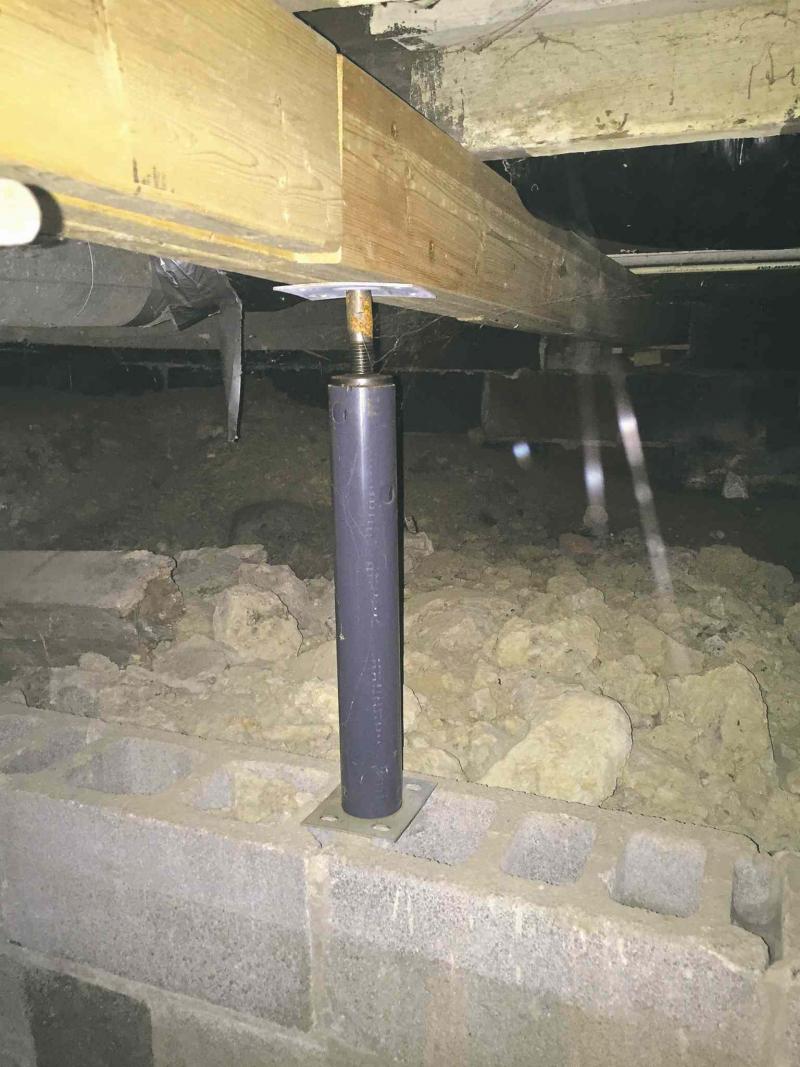
Question: I live in a walk-out bungalow on the La Salle River in La Salle. The house was built in 1989 and is piled, with a wooden structural floor. I noticed there was a separation between the floor and the baseboard in one corner of the room on the main floor level. By cutting out some of the wood floor, where the telepost was located, I discovered a short, six-inch telepost had come loose and was not sitting on the pile. The beam is made from four two-by-tens and needs to be raised about an inch. What is the best way to do this? I was thinking of using a 20-ton bottle jack to raise the beam and replace the telepost. Is this something I could try on my own or should I hire professional help?
Sharon Trosky
Answer: I am glad you are seeking guidance in your attempts to alleviate a structural issue in your home. Since you have already started by cutting holes in your floor, you are well on your way to making a major mistake, which may have ramifications for your home for years to come. Structural issues with homes, especially ones with modern engineered floor systems, should only be rectified by professionals to avoid more serious problems than the ones originally seen.
I'm afraid I am quite confused by your question, which may be due to the difficulty in explaining a complex situation, or your lack of proper terminology or knowledge about the issue. If I am confused, I can only imagine how a typical homeowner, such as yourself, can hope to understand such a complex structural issue enough to attempt repairs. My confusion may be with the location of the telepost in question relative to the sagging area in the corner of the main floor. Teleposts are rarely located below the corners of a floor, or even near an exterior wall. This is because they typically are located below a main beam to support it on a footing or concrete pier (pile) closer to the middle of the floor. If the main floor wall above the area in question is a simple partition wall, one between two main-floor interior rooms, then your inquiry makes more sense. That may be possible if this corner was over the middle of the floor, but I am still at a loss for the location of the telepost and pile.
Because you have a structural wood floor for the lower level of your bungalow, the top of the concrete piers should only be visible in the crawl space underneath this floor. I am not sure how you decided to cut a hole in this floor to look for a problem occurring in the floor above. If you are savvy enough to figure out that there may be a post or beam below the lower level floor, directly below the dropping main floor, entering the crawl space below this area should have been the way to inspect it. Cutting open the floor is likely an unnecessary action, as long as there is adequate clearance in the crawl space for entry. If there isn't, that is another whole can of worms we won't address at this time.
The fact that there is only a very short post below a large beam in this position makes me wonder if it is a true telepost or just a solid one. Teleposts are steel posts with adjustable, threaded rods at the top. If this is the case, adjusting this supporting device may fill in the gap below, rather than replacing the post. It is also odd that this is not sitting directly on the pile, as the adjustable top of a standard telepost normally sits on the steel cylinder by gravity, alone. In that case, any gap would either be above the telepost, under the beam, or between the threaded rod and a small steel plate secured to the beam.
To further complicate matters, if that's possible, many homes of your style have engineered floor systems. Some earlier versions of these systems installed in our area have had issues with floor movement, due to crushing of the I-joist ends or other defects, typically associated with high humidity present in crawl spaces. While you may be right that there will be corrective action needed at the loose post you found, that may only be the tip of the iceberg. If the loose post is caused by movement or damage to floor joists in other areas of the floor system, major repairs are highly likely. The only way to properly assess that condition would be a complete inspection of the crawl space, by manually entering and viewing the area.
Assessing the reason for significant dropping in the floor system in a home, especially one built on concrete piers and with an engineered structural floor system, may be difficult even for a well-seasoned home inspector like myself. It is surely beyond the scope of knowledge of the average homeowner and any further attempts on your part should be halted. Calling in a professional structural engineer, who has significant experience with residential engineered floor systems and structural wood floors, is your next move.
If I am correct about the presence of an engineered floor, look for stamps on the I-joists for the manufacturer's name. Contacting them directly, to send a representative or their own engineer to your home, may be even more prudent. Finding out what the true cause of the dropping floor is, and the proper repair, will only be possible by a highly trained professional engineer familiar with common defects in material or workmanship for your style and age of home.
Ari Marantz is the owner of Trained Eye Home Inspection Ltd. and the past president of the Canadian Association of Home & Property Inspectors -- Manitoba (cahpi.mb.ca). Questions can be emailed to the address below. Ari can be reached at 204-291-5358 or check out his website at trainedeye.ca.
trainedeye@iname.com



